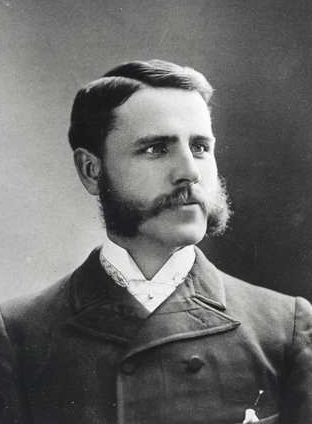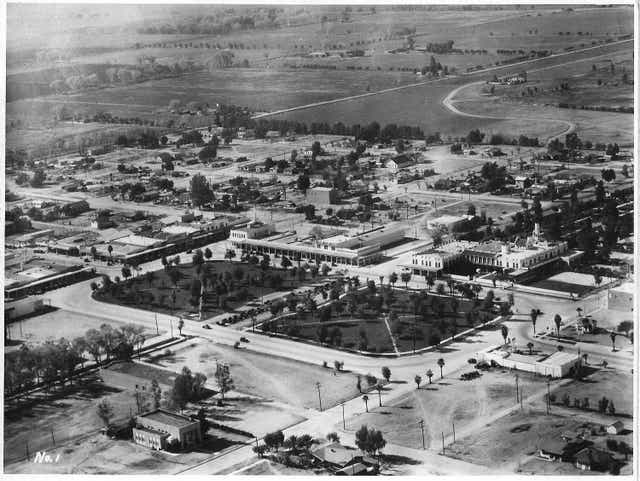In 1891, Dr. Alexander John Chandler, the first veterinary surgeon for the territory of Arizona, bought 80 acres of land from the federal government south of Mesa. Dr. Chandler studied the relatively new science of irrigation engineering and was instrumental in building an early system of canals.

By the turn of the century, Dr. Chandler owned an 18,000-acre ranch. With the help of planners and architects, Dr. Chandler subdivided his ranch and drew up a town site map. Dr. Chandler’s national advertising campaign for the sale of Chandler Ranch sites brought excursion trains filled with 300 speculators. They arrived on the newly completed Arizona Eastern Railroad and spent $50,000 for land that day.
At the time, Chandler consisted of three wooden shacks – the town site office, a dining hall and the Morrison Grocery. A billboard marked the site of the elegant future Hotel San Marcos. Dr. Chandler’s ambitious plan was a landscaped central park surrounded by businesses. Walkways in front of the buildings would be covered by a trellis-like roof, supported by colonnades.
Deed restrictions required land owners to build on their land within one year. And in that one year after the first land sale, Chandler had begun to look like an established town. Businesses had been built along the west and south side of the park, including the Bank of Chandler and the Eastern Railroad depot.
Dr. Alexander J. Chandler
Dr. A.J. Chandler was the Arizona Territory’s first veterinary surgeon. Entrepreneurial in spirit, he was a man with a vision. His ambitious plan transformed Chandler from a 3-building town to a beautiful landscaped central park surrounded by businesses. Walkways in front of the buildings were covered by trellis-like roofs, supported by colonnades.
All this was made possible, in part because Dr. Chandler studied the relatively new science of irrigation engineering. He was instrumental in building an early system of canals. For many years, Chandler and the man who founded it thrived. The Great Depression was not a devastating experience for most of Chandler’s residents.
The cotton crash of 1920 had a far greater impact on the agriculturally based economy. Dr. Chandler, however, did not fare so well during the depression years. The Bank of Chandler collapsed and he lost the San Marcos to his creditors. Able to retire comfortably, though, he lived in a cottage on the hotel grounds.
By the late 1930s, Chandler was experiencing some problems spurred by growth and technology. Drivers of the new faster cars sometimes didn’t realize that Arizona Avenue then ended at the town plaza. Cars often jumped the curb and drove right into the park. And the large diesel trucks that made deliveries to businesses around the park had trouble navigating the narrow roads around the plaza.
In 1940, the state proposed to align Route 87 down Arizona Avenue. Residents were not happy to see their beautiful park divided in half for a highway, but the town’s original design was no longer safe or practical.
In 1941, the U.S. Army Air Corps announced its plans for the construction of a fighter pilot training base east of Chandler. The base began operations in October and two months later Japanese bombers attacked Pearl Harbor. It soon became common to see uniformed men in town.
On August 14, 1945, Chandler residents celebrated late into the night when they received news of the end of the war.
During World War II, Chandler’s population doubled and reached 3,800 by 1950 — the year Dr. Chandler passed away. On May 24, 1954, the status of Chandler was upgraded from town to City.
In recent years, Chandler’s borders have been expanded and the population has boomed — from 30,000 in 1980 to more than 240,000 today. The economic base of Chandler has been diversified. While agriculture is still somewhat of a vital element, Chandler now enjoys a strong manufacturing and electronics sector.
The downtown storefronts have been restored to a modern version of their original turn-of-the-century look, and the plaza has been redesigned and named after the City’s founder. The Center for the Arts, new parks, restaurants, and retail centers mark an exciting future for the City.

Family festivals such as the Ostrich Festival, and a host of other annual events, make Chandler a popular draw for travelers from all across the country.
And the citizens of Chandler enjoy a quality of life unsurpassed in the Valley today. It certainly appears that Dr. Chandler knew what he was doing the day he dreamed of this paradise in the desert.

